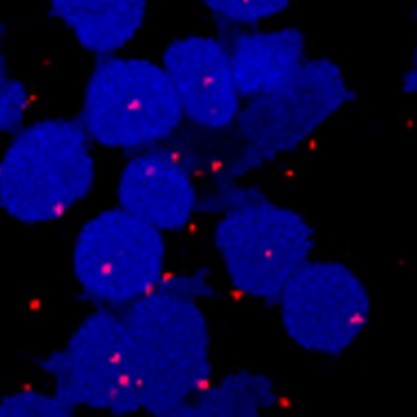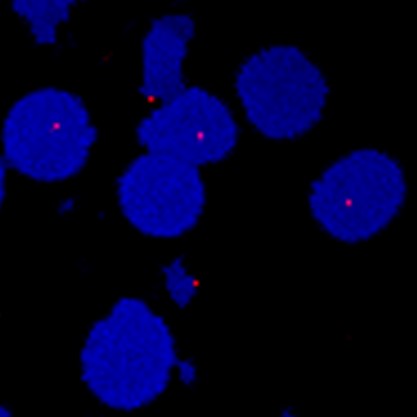Clinical trial exposes deadly kidney cancer's Achilles' heel
HIF-2α, a protein discovered at UTSW, is pivotal for progression of clear cell renal cell carcinomas and can be disabled by new experimental drug.


DALLAS – Feb. 14, 2020 – An experimental drug already shown to be safe and help some patients with clear cell renal cell carcinoma, a deadly form of kidney cancer, effectively disables its molecular target. The finding from a team of researchers at the UT Southwestern Medical Center’s Kidney Cancer Program, published in the Feb. 15 issue of Clinical Cancer Research, reveals a weakness in this cancer that could be further exploited with other targeted treatments in the future.
About 70,000 new cases of clear cell renal cell carcinoma (ccRCC) are diagnosed every year in the U.S. The five-year life expectancy after diagnosis is low compared with other cancers, at about 10-12 percent. Unlike many other forms of cancer, ccRCC doesn’t respond to chemotherapy or conventional radiation.
When study lead author James Brugarolas, M.D., Ph.D., professor of internal medicine (hematology/oncology) and director of the Kidney Cancer Program at UT Southwestern, began his career two decades ago, only one medication was approved to treat this cancer. There are now over a dozen approved drugs for ccRCC; however, says Brugarolas, each offers only a modest effect on survival and comes with a host of side effects.
Searching for better pharmaceuticals to fight this cancer, researchers at the Kidney Cancer Program focused on a protein known as hypoxia-inducible factor 2α (HIF-2α), which investigators at UTSW first discovered and described in the late 1990s. HIF-2α is a target of a tumor suppressor protein called von Hippel-Lindau (VHL) that’s characteristically inactivated in most cases of ccRCC. When HIF-2α pairs with HIF-1β, it’s able to regulate the expression of over 100 genes, including many that play key roles in cancer, such as those that control the formation of blood vessels or maintain stem cell-like qualities.
Although HIF-2α had long been considered undruggable, UTSW researchers identified a vulnerability in the protein structure in 2009 – a pocket that plays a key role in binding to HIF-1β. Eventually, researchers at UTSW identified compounds that bound this pocket, which served as the basis for the founding of Peloton Therapeutics Inc. in the UTSW BioCenter at Southwestern Medical District and the development of the HIF-2 inhibitor drug PT2385. After extensive preclinical testing in animal models, scientists at UTSW and their colleagues performed a phase one clinical trial that showed that this compound was safe, well tolerated, and effective at controlling cancer in 40 percent of patients.
Through an in-depth study of a subset of patients who participated in the phase one study and were willing to undergo extensive testing, the investigators sought to determine how well PT2385 blocked HIF-2α in ccRCC patients, how specific the effect was, and how important HIF-2α was for the cancer.
The researchers performed advanced MRIs to follow blood flow within patients’ tumors and took tumor biopsies, as well as blood samples, at different time points.
Their results showed that within two weeks after patients started on the drug, the amount of blood circulating in their tumors decreased by about 29 percent on average. While the cohort of patients tested was relatively small, the results suggested that the drug was starving tumors from blood, says Ivan Pedrosa, M.D., Ph.D., professor of radiology, chief of magnetic resonance imaging at UTSW, and co-leader of the study. Unlike all other drugs that seek to block blood flow to tumors, but do so everywhere, the effect of PT2385 was specific for the cancer.
Within tumors, tests on biopsied tissue showed that PT2385 effectively dissolved the HIF-2α/HIF-1β, blocking the complex from activating cancer-promoting genes. The effect was highly specific, and other related complexes, such as HIF-1α/HIF-1β were unaffected – showing its extreme specificity for HIF-2α.
After more than a year on PT2385, a patient’s tumor appeared to develop resistance to the drug, progressing unabated. Further tests revealed the development of a mutation within HIF-2α that prevented access by the drug to the pocket. The same mutation was found in a second patient.
Brugarolas says that the findings, which extend previous discoveries they reported in Nature, offer proof that HIF-2 is critical for ccRCC progression and that HIF-2α inhibitors such as PT2385 offer a novel and powerful weapon against this deadly disease.
“This study exposes the Achilles’ heel of ccRCC tumors,” says Brugarolas, who leads one of just two National Cancer Institute-designated Specialized Programs of Research Excellence (SPOREs) for kidney cancer in the U.S.
“Short of a cure, which we’re still struggling to get to patients, we think this drug and other future drugs in this class could offer a durable way to fight this cancer while preserving quality of life,” adds Kevin Courtney, M.D., Ph.D., UTSW associate professor of internal medicine (hematology/oncology) and first author of the study.
Brugarolas holds the Sherry Wigley Crow Cancer Research Endowed Chair in Honor of Robert Lewis Kirby, M.D. Ivan Pedrosa holds the Jack Reynolds, M.D., Chair in Radiology.
Other researchers who participated in this study include Yuanqing Ma, Alberto Diaz de Leon, Alana Christie, Zhiqun Xie, Layton Woolford, Nirmish Singla, Allison Joyce, Haley Hill, Ananth J. Madhuranthakam, Qing Yuan, Yin Xi, Yue Zhang, Jenny Chang, Oluwatomilade Fatunde, Yull Arriga, Arthu Frankel, Sanjeeva Kalva, Song Zhang, Tiffani McKenzie, Oscar Reig Torras, Renee M. McKay, Payal Kapur, and Tao Wang, all of UTSW; Robert A. Figlin, of Cedars-Sinai Medical Center; and Brian I. Rini, of Cleveland Clinic.
This work was supported by Cancer Prevention and Research Institute of Texas grant RP160440; NIH P50CA196516, as well as R01CA154475, U01CA207091, R03ES026397 and Cancer Center Support grant P30CA142543.
About UT Southwestern Medical Center
UT Southwestern, one of the premier academic medical centers in the nation, integrates pioneering biomedical research with exceptional clinical care and education. The institution’s faculty has received six Nobel Prizes, and includes 22 members of the National Academy of Sciences, 17 members of the National Academy of Medicine, and 14 Howard Hughes Medical Institute Investigators. The full-time faculty of more than 2,500 is responsible for groundbreaking medical advances and is committed to translating science-driven research quickly to new clinical treatments. UT Southwestern physicians provide care in about 80 specialties to more than 105,000 hospitalized patients, nearly 370,000 emergency room cases, and oversee approximately 3 million outpatient visits a year.
